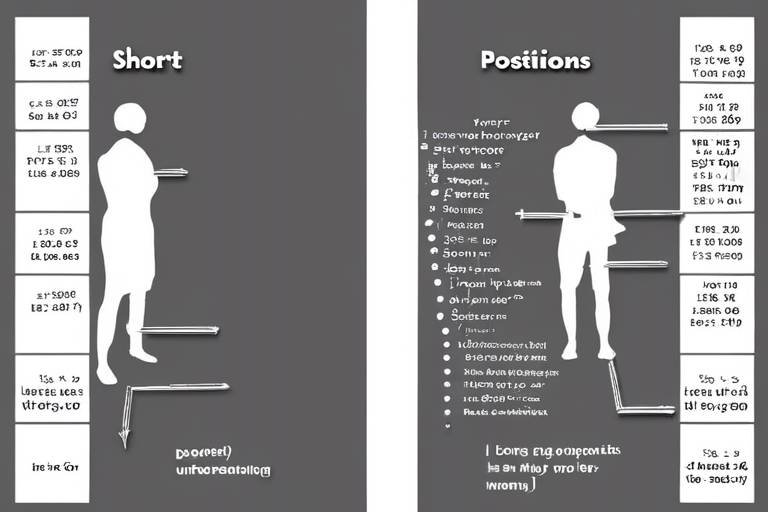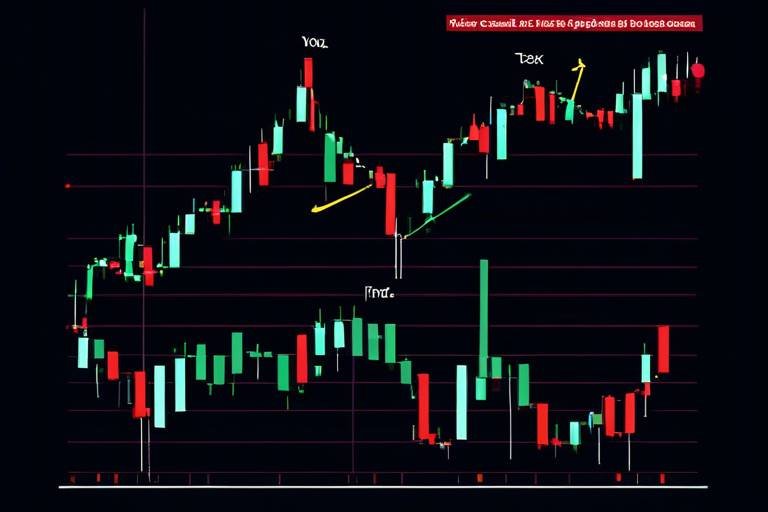Long vs. Short Positions - Understanding the Difference
Trading can often feel like a rollercoaster ride, with its ups and downs, twists and turns. At the heart of this financial thrill ride are two key concepts: long positions and short positions. Understanding these terms is crucial for anyone looking to navigate the trading landscape effectively. So, what exactly do they mean? In simple terms, a long position is when you buy an asset, betting that its price will rise. Conversely, a short position involves selling an asset you don’t own, with the expectation that its price will fall. But there’s so much more to these concepts than just their definitions!
In this article, we will explore the fundamental concepts of long and short positions in trading, highlighting their definitions, strategies, risks, and how they impact market dynamics. Whether you are a novice trader or a seasoned investor, grasping these concepts can significantly enhance your trading strategy and decision-making process. So, buckle up as we dive deeper into the fascinating world of trading!
A long position refers to buying an asset with the expectation that its price will rise. Imagine you purchase shares of a company, believing that its innovative products will drive future growth. If the company performs well and the stock price increases, you can sell your shares at a profit. This is the essence of a long position!
Long positions are often seen as a bullish strategy, reflecting optimism about the asset's future performance. Traders can employ various strategies when taking long positions, such as buy-and-hold, where they maintain their investment for an extended period, or dollar-cost averaging, where they invest a fixed amount regularly, regardless of the asset's price. These strategies can help mitigate risks and capitalize on potential price increases over time.
Now, let’s flip the coin! A short position involves selling an asset that one does not own, anticipating a price decline. It may sound counterintuitive, but it’s a strategy that savvy traders often use to profit from falling markets. Picture this: you believe that a particular stock is overvalued and will soon drop in price. You borrow shares from a broker and sell them at the current market price. If your prediction is correct and the stock price falls, you can buy back the shares at a lower price, return them to the broker, and pocket the difference.
Understanding the mechanics of short selling is essential for traders. The process begins with borrowing shares from a brokerage, which allows you to sell them without actually owning them. This is where margin accounts come into play. A margin account is a type of brokerage account that allows you to borrow funds to trade. When you short sell, you must maintain a certain level of equity in your margin account to cover potential losses.
While short selling can be lucrative, it carries unique risks, including unlimited potential losses. Unlike a long position, where the worst-case scenario is losing your entire investment, short selling can lead to losses that far exceed your initial investment. For example, if the stock price skyrockets instead of plummeting, you could find yourself in a precarious situation. Therefore, understanding these risks and employing risk management strategies is crucial for anyone considering short positions.
Short selling is also subject to various regulations designed to protect the market and prevent manipulation. For instance, the SEC (Securities and Exchange Commission) has implemented rules that require traders to locate and borrow shares before short selling them. Additionally, some markets impose restrictions during periods of high volatility. Being aware of these regulations is vital for traders to avoid penalties and ensure compliance.
When it comes to trading, understanding the differences between long and short positions is essential for making informed decisions. Here’s a quick comparison:
| Aspect | Long Position | Short Position |
|---|---|---|
| Expectation | Price will rise | Price will fall |
| Risk | Limited to investment | Unlimited potential losses |
| Market Sentiment | Bullish | Bearish |
By comparing these aspects, traders can better assess their strategies based on current market conditions and their risk tolerance.
Successfully managing long positions involves employing various strategies tailored to individual goals and market conditions. Some popular techniques include:
- Buy-and-Hold: This strategy involves purchasing an asset and holding onto it for the long term, allowing for potential appreciation.
- Dollar-Cost Averaging: Investing a fixed amount regularly, regardless of price fluctuations, helps mitigate the impact of volatility.
- Growth Investing: Focusing on companies with strong growth potential can lead to substantial returns over time.
Technical analysis plays a crucial role in identifying entry points for long positions. Traders often use key indicators and chart patterns, such as moving averages and support levels, to make informed decisions. By analyzing historical price movements, traders can gain insights into potential future trends and optimize their entry and exit strategies.
On the flip side, fundamental analysis helps traders evaluate the intrinsic value of assets. By examining financial metrics, such as earnings reports and economic indicators, traders can determine whether an asset is undervalued or overvalued. This analysis is essential for making informed long position decisions and ensuring that investments align with overall market trends.
Q: Can I have both long and short positions at the same time?
A: Yes, many traders use a strategy called hedging, where they hold both long and short positions to mitigate risk.
Q: What is the best strategy for beginners?
A: For beginners, a buy-and-hold strategy is often recommended, as it requires less active management and focuses on long-term growth.
Q: How can I manage risks associated with short selling?
A: Using stop-loss orders and maintaining a diversified portfolio can help manage risks when engaging in short selling.

What is a Long Position?
A long position is a fundamental concept in trading that refers to the act of buying an asset with the expectation that its price will increase over time. Imagine you're at a carnival, and you see a game where you can buy a ticket for a prize. You believe that the prize will become more valuable as the carnival progresses. Similarly, in trading, when you take a long position, you're betting on the future value of an asset, whether it's stocks, commodities, or cryptocurrencies.
When traders decide to go long, they're essentially saying, "I believe this asset will rise in value." This belief can stem from various factors, including market trends, economic indicators, or even gut feelings. The strategy is relatively straightforward: buy low and sell high. However, there’s more to it than just the basic premise. Successful long positions often involve careful analysis and timing.
There are several strategies that traders can employ when taking long positions. For instance, a buy-and-hold strategy involves purchasing an asset and holding onto it for an extended period, regardless of market fluctuations. This approach is akin to planting a seed and waiting for it to grow into a fruitful tree. On the other hand, some traders prefer a more active approach, engaging in dollar-cost averaging, which involves consistently investing a fixed amount of money at regular intervals. This method can help mitigate the impact of market volatility, much like averaging out the cost of groceries over a month instead of buying everything at once.
To better understand the dynamics of long positions, let’s look at a simple
| Scenario | Price at Purchase | Price at Sale | Profit/Loss |
|---|---|---|---|
| Scenario 1 | $50 | $70 | $20 Profit |
| Scenario 2 | $50 | $40 | $10 Loss |
In the above table, we can see two different scenarios of a long position. In Scenario 1, the trader buys at $50 and sells at $70, resulting in a profit. Conversely, in Scenario 2, the trader faces a loss when selling at $40. This example highlights the inherent risks involved in taking long positions, as the market can be unpredictable.
Understanding the market dynamics and the factors influencing asset prices is crucial for anyone considering a long position. Traders often rely on technical analysis to identify entry points. This involves studying price charts and patterns to predict future movements. Additionally, fundamental analysis plays a vital role, as it helps traders assess the intrinsic value of an asset based on financial metrics and economic indicators. It’s like checking the ingredients of a recipe before deciding if it’s worth making; you want to ensure that what you’re investing in has solid foundations.
In conclusion, a long position is a powerful tool in the trading arsenal, allowing investors to capitalize on their belief in the future growth of an asset. However, like any investment strategy, it requires careful consideration, research, and an understanding of the market landscape. By grasping the nuances of long positions, traders can navigate the financial waters with greater confidence and potentially reap significant rewards.

What is a Short Position?
A short position is a trading strategy that involves selling an asset that you do not currently own, with the expectation that its price will decrease. This might sound a bit counterintuitive, right? After all, most people buy low and sell high. But in the world of trading, there’s an entire universe where savvy traders look to profit from falling prices. Essentially, when you take a short position, you're betting against the market, hoping to buy back the asset at a lower price later on.
To understand how this works, let's break it down a bit. Imagine you believe that the stock of Company XYZ is overvalued at $100 per share. You decide to short the stock, so you borrow 10 shares from your broker and sell them immediately, pocketing $1,000. If your analysis is correct and the stock price drops to $70, you can then buy back those 10 shares for only $700. After returning the borrowed shares to your broker, you make a profit of $300. Sounds easy, right? However, the reality is that short selling is fraught with risks, and it’s not as straightforward as it seems.
When you short sell, you’re exposed to the potential for unlimited losses. Why? Because theoretically, there’s no cap on how high a stock price can go. If Company XYZ’s stock skyrockets to $200 instead of dropping, you would still need to buy back those shares to return them to your broker, leading to a loss of $1,000. This is why short selling is often considered a high-risk strategy, suitable primarily for experienced traders who can manage the inherent risks.
Moreover, short selling also requires a margin account, where you must maintain a certain amount of equity in your account as collateral for the borrowed shares. This brings us to another critical aspect of short selling: the margin call. If the value of the shares you’ve shorted rises significantly, your broker may require you to deposit additional funds to cover the potential losses, which can lead to a precarious financial situation.
In addition to understanding the mechanics, it’s crucial to be aware of the regulations surrounding short selling. Different markets have specific rules and restrictions that traders must follow. For example, some exchanges may impose a short-selling ban during periods of high volatility to prevent excessive downward pressure on stock prices. Being familiar with these regulations is key to navigating the world of short selling safely and effectively.
In summary, a short position is a powerful tool in a trader's arsenal, allowing them to profit from declining markets. However, it comes with its own set of complexities and risks. Understanding these factors is essential for anyone considering this strategy. Remember, while the potential for profit is enticing, the risks are equally significant, making it crucial to do thorough research and analysis before diving into short selling.

Mechanics of Short Selling
Understanding the mechanics of short selling is crucial for anyone looking to navigate the complex waters of financial trading. At its core, short selling is the practice of selling an asset that you do not own, with the expectation that the asset's price will decline. This might sound counterintuitive, but it’s a strategy that savvy traders often use to capitalize on falling markets.
So, how does this process work? First, a trader borrows shares of a stock from a broker. This borrowing typically involves a margin account, which allows the trader to borrow funds or securities. The broker lends the shares, and the trader sells them on the open market at the current market price. The goal here is simple: buy back the shares later at a lower price, return them to the broker, and pocket the difference as profit.
Here's a simplified breakdown of the steps involved in short selling:
- Borrowing Shares: The trader borrows shares from a brokerage firm, which may involve paying a fee for the borrowed shares.
- Selling the Borrowed Shares: The trader sells the borrowed shares at the current market price.
- Buying Back the Shares: At a later point, the trader buys back the same number of shares, ideally at a lower price.
- Returning Shares: Finally, the trader returns the borrowed shares to the broker, closing the short position.
For example, imagine a trader believes that Company X's stock, currently priced at $100 per share, is overvalued. The trader borrows 10 shares and sells them for $1,000. Later, when the stock price drops to $70, the trader buys back those 10 shares for $700 and returns them to the broker. The trader's profit in this case would be $300, minus any fees associated with borrowing the shares.
However, short selling isn’t without its challenges. If the price of the asset rises instead of falls, the potential for loss is theoretically unlimited. This is because there’s no cap on how high a stock price can go. For instance, if Company X's stock jumps to $150, the trader would need to buy back the shares for $1,500, resulting in a $500 loss. This risk makes short selling a high-stakes strategy, often requiring careful analysis and risk management.
Moreover, short selling is also subject to various regulations. Different markets have specific rules regarding short sales, including the uptick rule, which prevents short selling on a stock that has recently experienced a decline. Understanding these regulations is essential for any trader looking to short sell effectively.
In summary, the mechanics of short selling involve borrowing shares, selling them, and then buying them back at a lower price. While it can be a lucrative strategy, it also comes with significant risks that traders must navigate. As with any trading strategy, thorough research and a solid understanding of market dynamics are key to success.
- What is short selling?
Short selling is the practice of selling shares of a stock that you do not own, with the expectation that the stock's price will decline. - How do I short sell?
To short sell, you need to borrow shares from a broker, sell them on the market, and then buy them back later to return to the broker. - What are the risks of short selling?
The primary risk is that the price of the asset could rise instead of fall, leading to potentially unlimited losses. - Are there regulations on short selling?
Yes, short selling is subject to various regulations, which can vary by market and may include rules like the uptick rule.

Risks of Short Selling
Short selling can be a thrilling endeavor, akin to riding a roller coaster – exhilarating but fraught with potential pitfalls. When traders engage in short selling, they are essentially betting against the market, hoping that the price of an asset will decrease. However, this strategy carries unique risks that can lead to significant financial consequences. One of the most daunting risks is the potential for unlimited losses. Unlike taking a long position, where the maximum loss is capped at the initial investment, short sellers face the possibility of the price of the asset skyrocketing, leading to losses that can far exceed the initial capital used to open the position.
Moreover, short selling can also be affected by market volatility. When the market experiences sudden spikes or unexpected news, the price of the asset can surge, forcing short sellers to cover their positions at a loss. This phenomenon is often referred to as a "short squeeze," where a rapid increase in a stock's price forces short sellers to buy back shares to limit their losses, further driving up the price. It's a vicious cycle that can leave traders reeling.
Additionally, short sellers must consider the cost of borrowing shares. The process of short selling requires traders to borrow shares from a broker, and they often must pay a borrow fee. This fee can vary based on the availability of shares and market demand. If the borrowed shares become scarce, the cost can skyrocket, eating into potential profits or exacerbating losses.
Another critical aspect to keep in mind is the margin requirements. Short selling typically requires a margin account, and brokers impose strict margin requirements. If the value of the shorted stock rises significantly, traders may receive a margin call, necessitating them to deposit additional funds or close out their positions at a loss. This can create a highly stressful situation, as traders scramble to meet the demands of their brokers while the market continues to move against them.
To summarize, the risks associated with short selling include:
- Unlimited Loss Potential: Unlike long positions, where losses are capped, short sellers can face infinite losses if the asset price rises.
- Market Volatility: Sudden price spikes can lead to significant losses and trigger short squeezes.
- Borrowing Costs: Fees associated with borrowing shares can eat into profits and increase losses.
- Margin Calls: Traders may be required to deposit additional funds to maintain their positions, leading to forced selling.
In conclusion, while short selling can be a lucrative strategy for experienced traders, it is crucial to understand and manage the associated risks effectively. A well-informed trader will always weigh the potential rewards against the inherent dangers, ensuring that they are prepared for the roller coaster ride that is short selling.

Regulations Surrounding Short Selling
Short selling, while a powerful tool for traders looking to profit from declining markets, is also heavily regulated to prevent market manipulation and protect investors. Understanding these regulations is crucial for anyone considering engaging in short selling. In many jurisdictions, regulations can vary significantly, but they generally aim to ensure transparency and fairness in the markets.
One of the primary regulations that short sellers must be aware of is the uptick rule. This rule was designed to prevent excessive short selling during periods of rapid price decline. Essentially, it stipulates that a short sale can only be executed at a price that is higher than the last different price, which helps to mitigate the risk of a stock plummeting due to panic selling. While the uptick rule has been relaxed in some markets, it remains a critical aspect of short selling regulations.
Additionally, traders must understand the importance of regulation SHO, which mandates that short sellers must locate and borrow shares before executing a short sale. This regulation helps to ensure that short selling does not lead to an artificial increase in supply, which could destabilize the market. The requirement to borrow shares also implies that short sellers should be mindful of the availability of shares to borrow, as this can impact their ability to execute trades effectively.
Another key aspect of short selling regulations is the reporting requirements. In many markets, traders who engage in short selling must report their positions to regulatory bodies. This transparency is intended to provide oversight and help prevent market manipulation. For example, in the United States, the Securities and Exchange Commission (SEC) requires institutional investors to disclose their short positions on a quarterly basis, allowing regulators to monitor short selling activity more effectively.
Moreover, short selling is often subject to specific margin requirements. When traders short sell, they are borrowing shares and selling them with the intention of buying them back at a lower price. Because this involves borrowing, brokers typically require traders to maintain a certain level of equity in their margin accounts. If the value of the shorted stock rises, traders may receive a margin call, requiring them to deposit additional funds or close their positions to maintain compliance with margin regulations.
In summary, while short selling can be a lucrative strategy for traders, it's essential to navigate the complex regulatory landscape that governs these transactions. By understanding the uptick rule, regulation SHO, reporting requirements, and margin requirements, traders can better position themselves to engage in short selling responsibly and effectively. As regulations continue to evolve, staying informed about these changes is crucial for anyone looking to participate in short selling.
- What is short selling? Short selling is the practice of selling an asset that the seller does not own, with the expectation that the asset's price will decline.
- What are the risks associated with short selling? The primary risks include unlimited potential losses if the asset's price rises, and the obligation to cover the short position at a loss.
- How do regulations affect short selling? Regulations are in place to prevent market manipulation, ensure transparency, and require that shares are borrowed before short selling.
- What is the uptick rule? The uptick rule restricts short selling to occur only at a price higher than the last different price to prevent excessive downward pressure on a stock.

Comparing Long and Short Positions
When it comes to trading, understanding the nuances between long and short positions is crucial for any trader looking to navigate the financial markets successfully. While both strategies aim to capitalize on price movements, they operate on fundamentally different principles. A long position is like planting a seed, nurturing it, and waiting for it to grow; you're betting on the market's upward trajectory. In contrast, a short position is akin to betting against the grain, anticipating a decline in value and profiting from it. This fundamental difference is what makes the comparison between the two positions so fascinating.
To help clarify the distinctions, let's break down some of the key advantages and disadvantages of each approach:
| Aspect | Long Position | Short Position |
|---|---|---|
| Profit Potential | Unlimited (as the price can rise indefinitely) | Limited (maximum profit is capped at the initial price) |
| Risk Level | Lower risk; losses are limited to the initial investment | Higher risk; potential for unlimited losses if the price rises |
| Market Sentiment | Typically bullish; traders expect prices to increase | Generally bearish; traders expect prices to decrease |
| Investment Horizon | Can be long-term; suitable for buy-and-hold strategies | Usually short-term; often used for quick trades |
One of the most significant advantages of taking a long position is the potential for substantial gains. If you buy a stock at $50 and it rises to $100, your profit is clear and direct. However, the downside is that you’re limited to the amount you invested; if the stock drops to zero, that’s your loss. On the flip side, short selling can seem enticing because it allows traders to profit from falling prices. Imagine a stock you believe is overvalued at $100; if it drops to $50, you can buy it back at a profit. But beware! If the stock unexpectedly rises to $200, your losses could be astronomical.
Another factor to consider is market sentiment. Long positions thrive in bullish markets where optimism reigns, while short positions often flourish in bearish markets, where pessimism prevails. Knowing the market's mood can significantly influence your trading strategy. Moreover, the investment horizon plays a vital role; long positions can be part of a broader strategy, while short positions are usually more tactical, aimed at capitalizing on short-term price fluctuations.
In summary, the choice between long and short positions ultimately depends on your risk tolerance, market outlook, and trading strategy. Understanding the dynamics of both can empower you to make informed decisions that align with your financial goals.
- What is the primary difference between long and short positions? Long positions involve buying assets with the expectation of price increases, while short positions involve selling assets you don't own, anticipating price declines.
- Can I lose more money with a short position? Yes, short positions carry the risk of unlimited losses if the price of the asset rises significantly.
- What strategies can I use for long positions? Popular strategies include buy-and-hold, dollar-cost averaging, and growth investing.
- Are there regulations on short selling? Yes, short selling is subject to various regulations that traders must adhere to, including margin requirements and reporting obligations.

Strategies for Long Positions
When it comes to investing, having a solid strategy for long positions can be the difference between success and failure. A long position is essentially a bet that the price of an asset will increase over time, and there are several key strategies that traders can employ to maximize their potential gains. One of the most popular strategies is the buy-and-hold approach. This method involves purchasing an asset and holding onto it for an extended period, regardless of short-term market fluctuations. Think of it like planting a tree; you water it and take care of it, knowing that with time, it will grow and yield fruit.
Another effective strategy is dollar-cost averaging. This involves investing a fixed amount of money into an asset at regular intervals, regardless of its price. For example, if you invest $100 every month in a particular stock, you end up buying more shares when prices are low and fewer shares when prices are high. This strategy can help mitigate the risks associated with market volatility and can lead to a more favorable average cost per share over time.
Then there's growth investing, which focuses on identifying companies that are expected to grow at an above-average rate compared to their industry or the overall market. This strategy requires a keen eye for potential and often involves analyzing financial metrics such as earnings growth, revenue growth, and market share. Investors who employ this strategy are often willing to pay a premium for stocks that they believe will appreciate significantly in the future.
It's also essential to consider the role of diversification in long positions. By spreading investments across various assets, sectors, or geographies, traders can reduce their exposure to any single investment's risk. This strategy is akin to not putting all your eggs in one basket; if one investment underperforms, others can help cushion the blow.
In addition to these strategies, technical analysis can also play a crucial role in managing long positions. Traders often use various indicators and chart patterns to identify optimal entry and exit points for their investments. For instance, moving averages can help smooth out price data to identify trends, while support and resistance levels can indicate potential price points where an asset may reverse direction.
Lastly, fundamental analysis is vital for long-term success. By evaluating a company's financial health through metrics like earnings per share (EPS), price-to-earnings (P/E) ratio, and return on equity (ROE), traders can make informed decisions about whether to initiate or maintain a long position. Understanding the broader economic indicators, such as interest rates and inflation, can also provide valuable context for long-term investments.
In summary, successful long positions require a blend of strategies that include buy-and-hold, dollar-cost averaging, growth investing, diversification, technical analysis, and fundamental analysis. Each of these elements plays a vital role in navigating the complex landscape of investing, helping traders to make informed decisions and ultimately achieve their financial goals.
- What is a long position? A long position is when an investor buys an asset with the expectation that its price will rise over time.
- What are the benefits of a buy-and-hold strategy? The buy-and-hold strategy allows investors to ride out market volatility and benefit from long-term price appreciation.
- How does dollar-cost averaging work? Dollar-cost averaging involves investing a fixed amount of money at regular intervals, which helps to mitigate the impact of market fluctuations.
- What is growth investing? Growth investing focuses on identifying companies that are expected to grow at an above-average rate, often leading to higher potential returns.
- Why is diversification important? Diversification reduces the risk associated with individual investments by spreading exposure across different assets or sectors.

Technical Analysis for Long Positions
When it comes to trading long positions, technical analysis is your best friend. Imagine you're a detective, piecing together clues from charts and indicators to forecast future price movements. Technical analysis involves examining historical price data and trading volumes to identify patterns and trends that can inform your buying decisions. Traders use a variety of tools to make sense of the market, and understanding these tools can significantly enhance your chances of success.
One of the most fundamental aspects of technical analysis is the use of charts. Charts come in various forms, but the most popular are line charts, bar charts, and candlestick charts. Each type provides a different perspective on price movements. For instance, candlestick charts not only show the opening and closing prices but also the highs and lows for a specific time period, giving traders a comprehensive view of market sentiment. By analyzing these charts, traders can spot potential entry points for their long positions.
Another critical component of technical analysis is the use of indicators. These mathematical calculations are based on price, volume, or open interest, and they help traders make informed decisions. Some of the most widely used indicators include:
- Moving Averages: These smooth out price data to identify trends over a specific period. A simple moving average (SMA) can help traders spot when to enter or exit a long position.
- Relative Strength Index (RSI): This momentum oscillator measures the speed and change of price movements, helping traders identify overbought or oversold conditions.
- MACD (Moving Average Convergence Divergence): This indicator shows the relationship between two moving averages of a security’s price, helping traders identify potential buy signals.
But, wait! It’s not just about the indicators. You also need to understand support and resistance levels. Support is the price level at which a stock tends to stop falling and may bounce back up, while resistance is where it tends to stop rising and may fall back down. Recognizing these levels can help traders set their entry points for long positions, as buying near support can minimize risk while maximizing potential gains.
Moreover, chart patterns such as head and shoulders, triangles, and flags can also provide valuable insights. For example, a bullish flag pattern often indicates a continuation of an upward trend, suggesting that it might be a good time to enter a long position. By combining these patterns with indicators, traders can enhance their decision-making process.
In conclusion, mastering technical analysis is essential for anyone looking to take long positions in the market. By using charts, indicators, and understanding key concepts like support and resistance, you can develop a robust strategy that increases your chances of success. Remember, trading is not just about luck; it’s about informed decisions backed by solid analysis.
1. What is technical analysis?
Technical analysis is the study of historical price data and trading volumes to forecast future price movements. It involves using charts and indicators to identify trends and patterns.
2. How do moving averages help in trading?
Moving averages help traders smooth out price data to identify trends over a specific period, making it easier to spot potential entry and exit points for trades.
3. What are support and resistance levels?
Support levels are price points where a stock tends to stop falling and may bounce back up, while resistance levels are where it tends to stop rising and may fall back down.
4. Can technical analysis be used for all types of assets?
Yes, technical analysis can be applied to various assets, including stocks, commodities, forex, and cryptocurrencies, as long as there is historical price data available.

Fundamental Analysis for Long Positions
When it comes to investing, understanding the intrinsic value of an asset is crucial, especially for those looking to take long positions. Fundamental analysis is a method that evaluates a security's value by examining various economic, financial, and other qualitative and quantitative factors. Think of it as a detective story where you gather clues about a company’s performance to determine if its stock is undervalued or overvalued. By diving deep into a company’s financial health, you can make informed decisions about whether to buy and hold its stock for the long term.
At its core, fundamental analysis involves looking at several key components:
- Financial Statements: These are the backbone of fundamental analysis. Investors scrutinize the income statement, balance sheet, and cash flow statement to assess a company's profitability, debt levels, and cash generation capabilities. For instance, a company with consistent revenue growth and low debt might be a strong candidate for a long position.
- Economic Indicators: Broader economic factors such as GDP growth, unemployment rates, and inflation can significantly impact a company's performance. A thriving economy usually leads to increased consumer spending, which can boost a company's sales and, consequently, its stock price.
- Industry Analysis: Understanding the industry in which a company operates is essential. Factors like market competition, regulatory environment, and technological advancements play a significant role in a company's success. A company in a growing industry might provide better long-term returns than one in a stagnant sector.
Moreover, it's important to consider qualitative factors as well. These might include the company's management team, brand strength, and market position. A strong leadership team with a clear vision can steer a company through tough times, making it a more attractive long-term investment. For example, tech giants like Apple and Google thrive not just because of their products, but also due to their innovative leadership and strong brand loyalty.
To illustrate the importance of fundamental analysis, let’s take a look at a hypothetical example:
| Company | Revenue Growth (Year-over-Year) | Debt-to-Equity Ratio | Price-to-Earnings (P/E) Ratio |
|---|---|---|---|
| Tech Innovations Inc. | 15% | 0.5 | 20 |
| Old School Manufacturing | 2% | 1.2 | 12 |
In this table, Tech Innovations Inc. shows strong revenue growth and a low debt-to-equity ratio, suggesting it is in a healthy financial position. In contrast, Old School Manufacturing has stagnant growth and higher debt, which might make it less appealing for long-term investment. By applying fundamental analysis, an investor can easily identify that Tech Innovations is likely a better candidate for a long position.
Ultimately, the goal of fundamental analysis is to help investors make informed decisions about their investments. By understanding the true value of a company, you can better navigate the stock market's ups and downs and increase your chances of long-term success. Remember, investing is not just about picking stocks; it’s about understanding the story behind them.
- What is the difference between fundamental analysis and technical analysis? Fundamental analysis focuses on a company's financial health and economic factors, while technical analysis examines price movements and trading volumes.
- How long should I hold a long position? The duration of a long position can vary depending on your strategy, market conditions, and the performance of the asset. Some investors hold for years, while others may sell after achieving short-term gains.
- Can fundamental analysis predict stock prices? While it can provide insights into a company's value and potential growth, stock prices are influenced by many factors, and no analysis can guarantee outcomes.
Frequently Asked Questions
- What is the main difference between long and short positions?
The main difference lies in the direction of the trade. A long position is taken when a trader buys an asset anticipating that its price will increase, while a short position is initiated by selling an asset they do not own, expecting its price to fall. Essentially, one bets on the price going up, and the other bets on it going down.
- How do I take a long position in the market?
To take a long position, you simply buy the asset you believe will rise in value. This could be stocks, commodities, or currencies. You hold onto the asset until you feel it has reached a satisfactory price for selling, thus realizing a profit. It's like planting a seed and waiting for it to grow into a tree!
- What are the risks associated with short selling?
Short selling carries significant risks, primarily because the potential losses are unlimited. If the asset's price rises instead of falls, you could end up losing more than your initial investment. It's like borrowing a book and hoping it becomes less popular; if it gains fame instead, you might have to pay a hefty price!
- Can I lose more money with a short position than I invested?
Yes, absolutely! When you short sell, your losses can theoretically be infinite because there's no cap on how high a stock price can go. If it skyrockets, you must buy back the shares at a much higher price than you sold them for, leading to substantial financial loss.
- What strategies can I use for long positions?
There are several strategies for managing long positions effectively. Popular ones include buy-and-hold, where you purchase an asset and hold it for the long term, and dollar-cost averaging, which involves investing a fixed amount regularly regardless of the asset's price. This strategy helps mitigate the impact of market volatility.
- How does technical analysis help with long positions?
Technical analysis involves studying price charts and indicators to identify optimal entry and exit points for long positions. Traders look for patterns, trends, and signals that suggest when to buy and sell, much like a navigator using stars to chart a course through the night sky.
- What is the role of fundamental analysis in trading long positions?
Fundamental analysis focuses on evaluating the intrinsic value of an asset based on economic indicators, financial metrics, and market conditions. It helps traders determine whether an asset is undervalued or overvalued, guiding their decisions on whether to take a long position.
- Are there regulations I should be aware of when short selling?
Yes, short selling is subject to various regulations, including rules on margin requirements and short-selling restrictions during volatile market conditions. It's crucial to stay informed about these regulations to avoid potential pitfalls and ensure compliance.



















